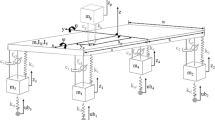Abstract
This paper presents the comparison results of a study to identify an appropriate semi-active control algorithm for a MR suspension system from a variety of semi-active control algorithms for use with MR dampers. Five representative control algorithms are considered including the skyhook controller, the hybrid controller, the LQG controller, the sliding mode controller and the fuzzy logic controller. To compare the control performances of the five control algorithms, a quarter car model with a MR damper is adopted as the baseline model for our analysis. After deriving the governing motion equations of the proposed dynamic model, five controllers are developed. Then each control policy is applied to the baseline model equipped with a MR damper. The performances of each control algorithm under various road conditions are compared along with the equivalent passive model in both time and frequency domains through the numerical simulation. Subsequently, a road test is performed to validate the actual control performance. The results show that the performance of a MR suspension system is highly dependent on the choice of algorithm employed, and the sliding mode control strategy exhibits an excellent integrated performance.
Similar content being viewed by others
References
Hassan, S.A., Sharp, R.S.: The relative performance capability of passive, active and semi-active car suspension systems. SAE technical paper series 864901 (1986)
Lou, Z., Ervin, R.D., Filisko, F.E.: A preliminary parametric study of electrorheological dampers. Trans. ASME J. Fluids Eng. 116(3), 570–576 (1994)
Sassi, S., Cherif, K., Mezghani, L., Thomas, M., Kotrane, A.: An innovative magnetorheological damper for automotive suspension: from design to experimental characterization. Smart Mater. Struct. 14, 811–822 (2005)
Lam, A.H.-F., Liao, W.-H.: Semi-active control of automotive suspension systems with magneto-rheological dampers. Int. J. Veh. Des. 33(1/2/3), 50–75 (2003)
Nguyen, Q.H., Choi, S.B.: Optimal design of MR shock absorber and application to vehicle suspension. Smart Mater. Struct. 18(3), 035012 (2009)
Lee, H.S., Choi, S.B.: Control and response characteristics of a magneto-rheological fluid damper for passenger vehicles. J. Intell. Mater. Syst. Struct. 11(1), 80–87 (2000)
Choi, S.B., Lee, H.S., Park, Y.P.: H-infinity control performance of a full-vehicle suspension featuring magnetorheological dampers. Veh. Syst. Dyn. 38(5), 341–360 (2002)
Batterbee, D.C., Sims, N.D.: Hardware-in-the-loop simulation of magnetorheological dampers for vehicle suspension systems. Proc. Inst. Mech. Eng., Part I: J. Syst. Control Eng. 221(2), 265–278 (2007)
Crosby, M.J., Harwood, R.A., Karnopp, D.: Vibration control using semi-active force generators. Lord Library of Technical Articles LL-7004 (1973)
Ahmadian, M., Simon, D.E.: An analytical and experimental evaluation of magneto rheological suspensions for heavy trucks. Veh. Syst. Dyn. 37, 38–49 (2002)
Ahmadian, M., Vahdati, N.: Transient dynamics of semiactive suspensions with hybrid control. J. Intell. Mater. Syst. Struct. 17(2), 145–153 (2006)
Wang, E.R., Ma, X.Q., Rakheja, S., Su, C.Y.: Semi-active control of vehicle vibration with MR-dampers. In: Proceedings of the 42nd IEEE Conference on Decision and Control, Maui, HI, December (2003)
Guo, D.L., Hu, H.Y., Yi, J.Q.: Neural network control for a semi-active vehicle suspension with a magnetorheological damper. J. Vib. Control 10(3), 461–471 (2004)
Yagiz, N., Sakman, L.E.: Robust sliding mode control of a full vehicle without suspension gap loss. J. Vib. Control 11(11), 1357–1374 (2005)
Yu, M., Liao, C.R., Chen, W.M., Huang, S.L.: Study on MR semi-active suspension system and its road testing. J. Intell. Mater. Syst. Struct. 17(8–9), 801–806 (2006)
Eslaminasab, N., Biglarbegian, M., Melek, W.W., Golnaraghi, M.F.: A neural network based fuzzy control approach to improve ride comfort and road handling of heavy vehicles using semi-active dampers. Int. J. Heavy Veh. Syst. 14(2), 135–157 (2007)
Choi, S.B., Lee, S.-K., Park, Y.P.: A hysteresis model for the field-dependent damping force of a magnetorheological damper. J. Sound Vib. 245(2), 375–383 (2001)
Sung, K.G., Han, Y.M., Lim, K.H., Choi, S.B.: Discrete-time fuzzy sliding mode control for a vehicle suspension system featuring an electrorheological fluid damper. Smart Mater. Struct. 16(3), 798–808 (2007)
Fang, X., Chen, W., Wu, L., Wang, Q., Fan, D., Li, Z.: Fuzzy control technology and the application to vehicle semi-active suspension. Chinese J. Mech. Eng. 35(3), 98–100 (1999)
Dong, X.M., Liao, C.R., Chen, W.M., Zhang, H.H., Huang, S.L.: Adaptive fuzzy neural network control for transient dynamics of magneto-rheological suspension with time-delay. In: Adv. Neural Netw. ISNN 2006, Pt. 2, Proc. Lecture Notes in Computer Science, vol. 3972, pp. 1046–1051. Springer, Berlin (2006)
Yang, J.W., Li, J., Du, Y.P.: Adaptive fuzzy control of lateral semi-active suspension for high-speed railway vehicle. In: Comput. Intell., Pt. 2, Proc. Lecture Notes in Computer Science, vol. 4114, pp. 1104–1115. Springer, Berlin (2006)
Ying, Z.G., Zhu, W.Q., Soong, T.T.: A stochastic optimal semi-active control strategy for ER/MR damper. J. Sound Vib. 259(1), 45–62 (2003)
Sims, N.D., Peel, D.J., Stanway, R., Johnson, A.R., Bullough, W.A.: The electrorheological long-stroke damper: a new modeling technique with experimental validation. J. Sound Vib. 229(2), 207–227 (2000)
Spencer, B.F., Dyke, S.J., Sain, M.K., Carlson, J.D.: Phenomenological model for magnetorheological dampers. J. Eng. Mech. 123(3), 230–238 (1997)
Chang, C.C., Roschke, P.: Neural network modeling of a magnetorheological damper. J. Intell. Mater. Syst. Struct. 9(9), 755–764 (1998)
Ahmadian, M.: A hybrid semi-active control for secondary suspension applications. In: ASME International Congress and Exposition, November 16–21, Dallas, TX (1997)
Yokoyama, M., Hendrick, J.K., Toyama, S.: A model following sliding mode controller for semi-active suspension systems with MR dampers. In: Proceedings of the American Control Conference Arlington, VA, June 25–27, pp. 2652–2657 (2001)
Zhao, H., Lu, S.: A vehicle’s time domain model with road input on four wheels. Automot. Eng. 21(2), 112–117 (1999)
Author information
Authors and Affiliations
Corresponding author
Rights and permissions
About this article
Cite this article
Dong, Xm., Yu, M., Liao, Cr. et al. Comparative research on semi-active control strategies for magneto-rheological suspension. Nonlinear Dyn 59, 433–453 (2010). https://doi.org/10.1007/s11071-009-9550-8
Received:
Accepted:
Published:
Issue Date:
DOI: https://doi.org/10.1007/s11071-009-9550-8




